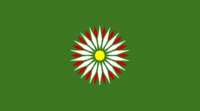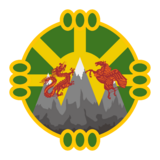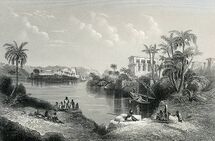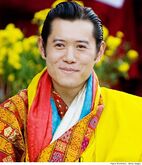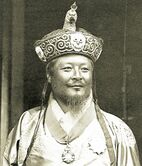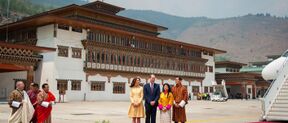Namdatka
Republic of the Union of Namdatka ཨཿོམེ་ཨོཕ༹་ཐེ་ཊིབེཏ (Kzhongka) | |
|---|---|
 Map of Namdatka | |
| Capital | Khasa |
| Demonym(s) | Namdatkan |
| Government | Unitary Careleon Absolute Necrocratic Monarchy |
• Eternal Dragon King | Ugyen Gongsar |
• King | Tshering I |
| Population | |
• 2018 census | 876,498 |
| Currency | Namdatkan ngultrum |
| Date format | mm/dd/yy |
| Driving side | left |
| Internet TLD | .nd |
This article is incomplete because it is pending further input from participants, or it is a work-in-progress by one author. Please comment on this article's talk page to share your input, comments and questions. Note: To contribute to this article, you may need to seek help from the author(s) of this page. |
Namdatka (Kzhongka: ཨཿོམེ་ཨོཕ༹་ཐེ་ཊིབེཏ་), officially the Republic of the Union of Namdatka is a landlocked country in central Orient. With a population of around 870,000 and a land area of around X km2, Namdatka is one of the Orient's smallest nations. It is bordered by Mahana to the east and Chyrcassia to the west as well as closely to Mantella in the west. Namdatka is located entirely within the Careleon Plateau, with most people living in the cooler eastern regions on the border with Mahana. The capital is Khasa but other large metropolitan areas include Dolka, Khedrup and Gonpo.
Etymology
(WIP.)
History
Prehistory
WIP.
Kzhongkan Migration
WIP.
Gyeltshen Dynasty
WIP.
Religious Tension
WIP.
Rai Monarchal Period
During the 15th and 16th centuries Namdatka's eastern regions, especially around the city of Lwhang Tenchwa, existed a monarchy that grew out of the ancient Gyeltshen Dynasty that ruled over the realm it called Tsheringa. This monarchy made claim to an area of around 98,000 km2, containing around 90,000 people at the time. The land was arid and dry, leading to a majority of the population being situated around the Penden River in settlements around Lwhang Tenchwa. The Rai Monarchy ruled this kingdom with an iron-fist, however it flourished in comparison to the eastern regions at the time, which were under the subjugation of Mahana.
The monarchy continued it's existence up until the foundation of Namdatka in 1780, where they joined the Union of Namdatka in exchange for Namdatka taking up the Rai Monarchy. This was what lead to the royal family of Namdatka being a part of the minority Ramarchops ethnic group.
War for Independence
At the end of the 18th century, during the times of great religious struggle in neighbouring Mahana, a movement arose with the native Namdatkan people group living in Mahana which eventually lead to a diplomatic feedback loop which slowly turned into an escalated conflict.
The revolution began on the 6th May 1780, with uprising beginning in the city of Khasa. It initially was met with resistance from the Mahanans however due to struggles within the rest of the country the decision was made to grant the nation their independence only a month after, on the 17th June 1790. The war, despite being short-lived, lead to independence which lasts into present day.
Dungchu Dictatorship
In October 1911, the military lead by the Dungchu family, a wealthy family with close ties to the monarchy, began a Coup d'état which lead to the rise of the Dungchu Dictatorship, who originally promised the people to form a democratic government but instead took complete power over the nation and having the royal family put into exile in Mekabiri.
Post-Dictatoral Namdatka
Monarchal Return
Contemporary History
(WIP. Look at neighbours Mahana and Mantella.)
Geography
Climate
The climate is severely dry nine months of the year, and average annual snowfall is only 46 cm due to the rain shadow effect. Eastern passes and regions receive small amounts of fresh snow and occasionally rain throughout the course of the year. Low temperatures are prevalent throughout these eastern regions, where bleak desolation is unrelieved by any vegetation bigger than a low bush, and where the wind sweeps unchecked across vast expanses of arid plain. The Oriental Narope Rains have influence on it's eastern regions, with some years having a much higher average rainfall than others.
(WIP. Landscape. Climate.)
Politics
Government
Namdatka is the wurlds sole necrocracy, having Eternal Dragon King Ugyen Gongsar serving as head of state despite passing away in 1930. The system came into place in 1925 when Gongsar, ruling king at the time, decided to proclaim himself as the "Eternal King of Namdatka and her Lands". Following his death in 1930, he remained as the nations de-facto head of state despite holding no obvious power. The people have kept this tradition alive as Ugyen Gongsar is said to be the direct descendent of Namdatkan Gai goddess Drakthonpa and taking away his position would be seen as blasphemy. Despite this, all actions within the country are run by the reigning monarch, currently Tshering I, and his council which he elects.
(WIP. Government. Political parties. Foreign relations. Military.)
Economy
(WIP. Eployment. Exports. Energy. Transport. Media. Currency.)
Demographics
Ethnic Groups
Namdatkan people are mostly made up of two groups, the Nkalops and the Ramarchops, otherwise known as the eastern and western Namdatkan people. The eastern Nkalops people are larger in demographic size, making up 79% of Namdatkas population. Despite this, historically the Ramarchops people have had more political power than the Nkalops, with the royal family all being a part of the group. (WIP. Ethnic groups. Language. Religion. Health. Education.)
Cultures
(WIP. Literature. Visual arts. Music. Cuisine. Sport.)
